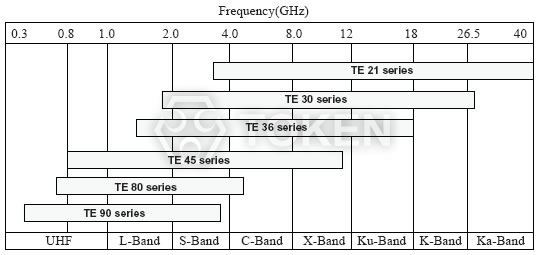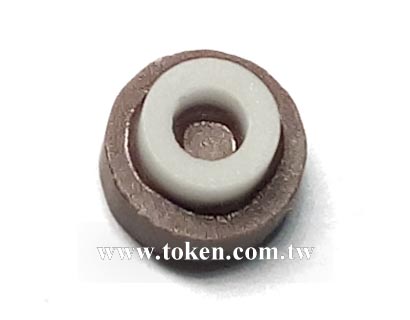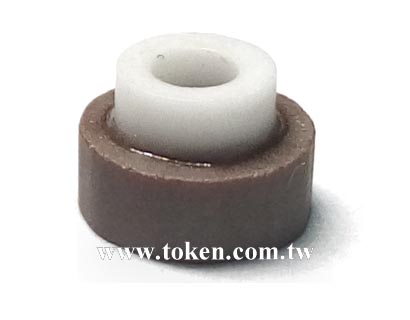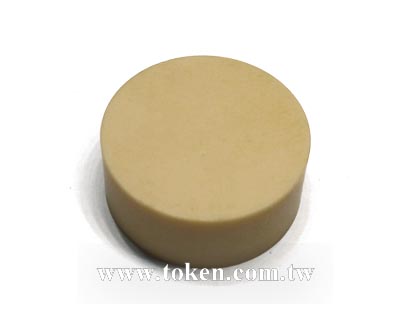Dielectric Resonators & Materials (TE)
Microwave Dielectric Resonators & Materials (TE) Introduction
Microwave dielectric resonator material is the cornerstone of future communications technology (TE01δ Mode). Microwave dielectric ceramics as the key basic materials to modern communication technology, after Token Electronics years of continuous research and development, using the latest technology to produce microwave ceramics have achieved a variety of dielectric constant, quality factor Q of the new media ceramic materials, and as a dielectric material application microwave frequencies of modern circuits, and modern electronic communications in the filters, resonators, dielectric substrates, such as microwave dielectric waveguide circuit components materials.
Comparing with microwave dielectric components made of Token's ceramic materials and metal cavity resonator, obviously, Token dielectric resonator features with a light weight, small volume, temperature coefficient of stability, cheap, and so on. They have been widely used in satellite broadcast reception systems, PCS / PCN filters, base stations, radar detectors, wireless mobile communications, telecommunications computer systems, military facilities, microwave, modern medicine and many other areas.
Taking advantage of Token's microwave dielectric ceramic materials for dielectric filters and resonators, with a relatively high dielectric constant, can make the device smaller, space-saving design of the circuit; high quality factor Q value and low dielectric loss, in order to ensure a good selection frequency characteristics and low insertion loss of the device; the temperature coefficient is small, in order to ensure the thermal stability of the device. Dielectric constant, quality factor Q, the temperature coefficient, these three parameters to evaluate the important microwave dielectric ceramic material specifications and production.
Custom parts are available on request. Token will also produce devices outside these specifications to meet specific customer requirements,
please contact our sales for more information.
Download Dielectric Resonators & Materials (TE) Datasheet PDF.
- Police Radar Detectors. Dielectric Resonator Antennas.
- LMDS/MMDS Wireless Cable TV. Automobile Collision Avoidance Sensors.
- LNB, PCS/PCN Filters, Duplexer & Combiners. Cellular Base Station Filter, Duplexer & Combiners.
- High Q Value. Easy to control τ f.
- Various dielectric constant materials.
Available Range by Every Material TE01δ Mode (TE)
| Material Series | Dielectric Constant |
Fo Q(1/tanδ) | Temperature Coefficient (PPM/°C) |
Insulation Resistance (Ω-cm) |
Application Frequency Range |
Application Range |
| TE21 | 19~22 | 6,000@10GHz | 0 ± 3 | >1014 | Refer Frequency Chat |
Refer Frequency Chat |
| TE30 | 29~30 | 15,000@10GHz | 0 ± 6 | >1014 | ||
| TE36 | 35~37 | 10,000@4GHz | 0 ± 3 | >1014 | ||
| TE45 | 44~46 | 10,000@4GHz | 0 ± 6 | >1014 | ||
| TE80 | 79~81 | 7,000@1GHz | 0 ± 6 | >1014 | ||
| TE90 | 89~91 | 7,000@1GHz | 0 ± 6 | >1014 |
Frequency Chart of Every Material TE01δ Mode (TE)

TE01δ Mode (TE) Frequency Chart |
Application Notice TE01δ Mode (TE)
Aging :Water Absorbing :
Ceramics absorb water is not obvious, but the moisture condensation in the ceramic microwave resonator on the surface will affect the Qu. But Qu will be self-healing, when the water dried, For example, Dielectric resonator in the filter operation of the self-heating.
Dielectric Constant :
In fact, the microwave dielectric ceramics of the dielectric constant is not fixed. It varies with the additives added, and used to determine the temperature coefficient ceramics. The dielectric constant of each batch is slightly different and it changes slightly with temperature changes. Token compensates for these effects and provide resonators size to frequency, and offers custom temperature coefficient on request.
Dielectric loss factor tanδ & Qu :
Dielectric loss factor and quality factor of the relationship, such as Quality Factor (Q = 1 / tanδ), Dielectric microwave materials are commonly assigned a loss tangent to permit an estimate of signal losses. Ceramic resonator is usually run on a specific frequency, a specific geometric shape, it can directly measure its size, with no-load quality factor Qu, Qu is an important basic resonator parameters (more useful than the loss tangent), particularly suitable filter and oscillator applications.
Ceramic hard surface contact, it is prone to very small fragments. Most of the small fragments will not affect the electrical properties of dielectric ceramics. Ceramic surface roughness is not particularly important factor. Ceramic resonator itself does not current exist only in the form of stored energy from the field. Smooth surfaces are desirable from the standpoint of avoiding trapped contaminants.
Cleanliness :
Qu degradation of the oil may be due to a finger, pencil lead note, tape, adhesives, or other contaminants. Cleanliness of the dielectric ceramics is important.
Thermal Shock :
Microwave dielectric ceramics in the temperature exceeds 1200° in furnace to burn out, they can be more resistant than the temperature of electronic devices, far beyond the welding temperature. However, the thermal conduction velocity of dielectric ceramics is much slower than the metal. Large temperature gradient through the ceramic device, because of uneven expansion, could lead to device failure, which is called thermal shock. Suddenly applied heat in the thick ceramic devices will lead to broken ceramics.
Adhesives :
Adhesives to install ceramic resonators must be carefully selected. Adhesives will reduce the dielectric ceramics Q u, The right adhesives can reduce Qu to a minimum, while ensuring the adhesion strength.
Order Codes TE01δ Mode (TE)
| TE | 36 | - | 10 | A | S | |||||||||||||||
 |
 |
 |
 |
 |
||||||||||||||||
|
|
|
|
|
||||||||||||||||



